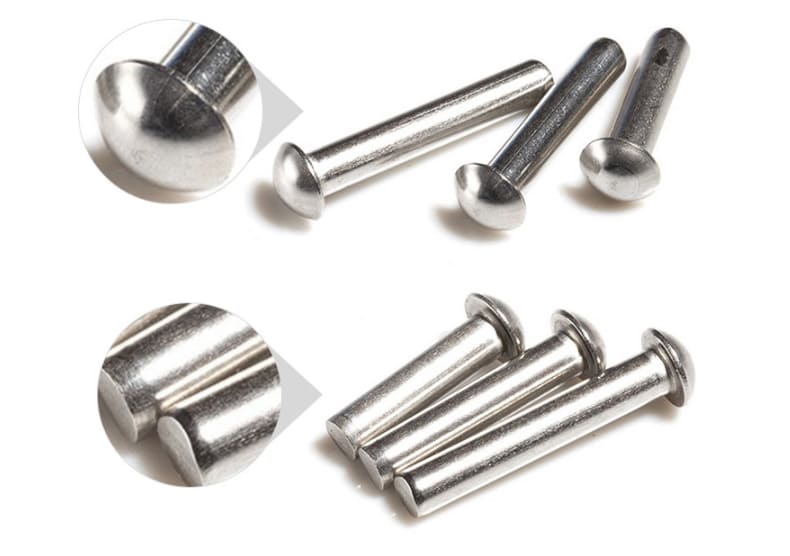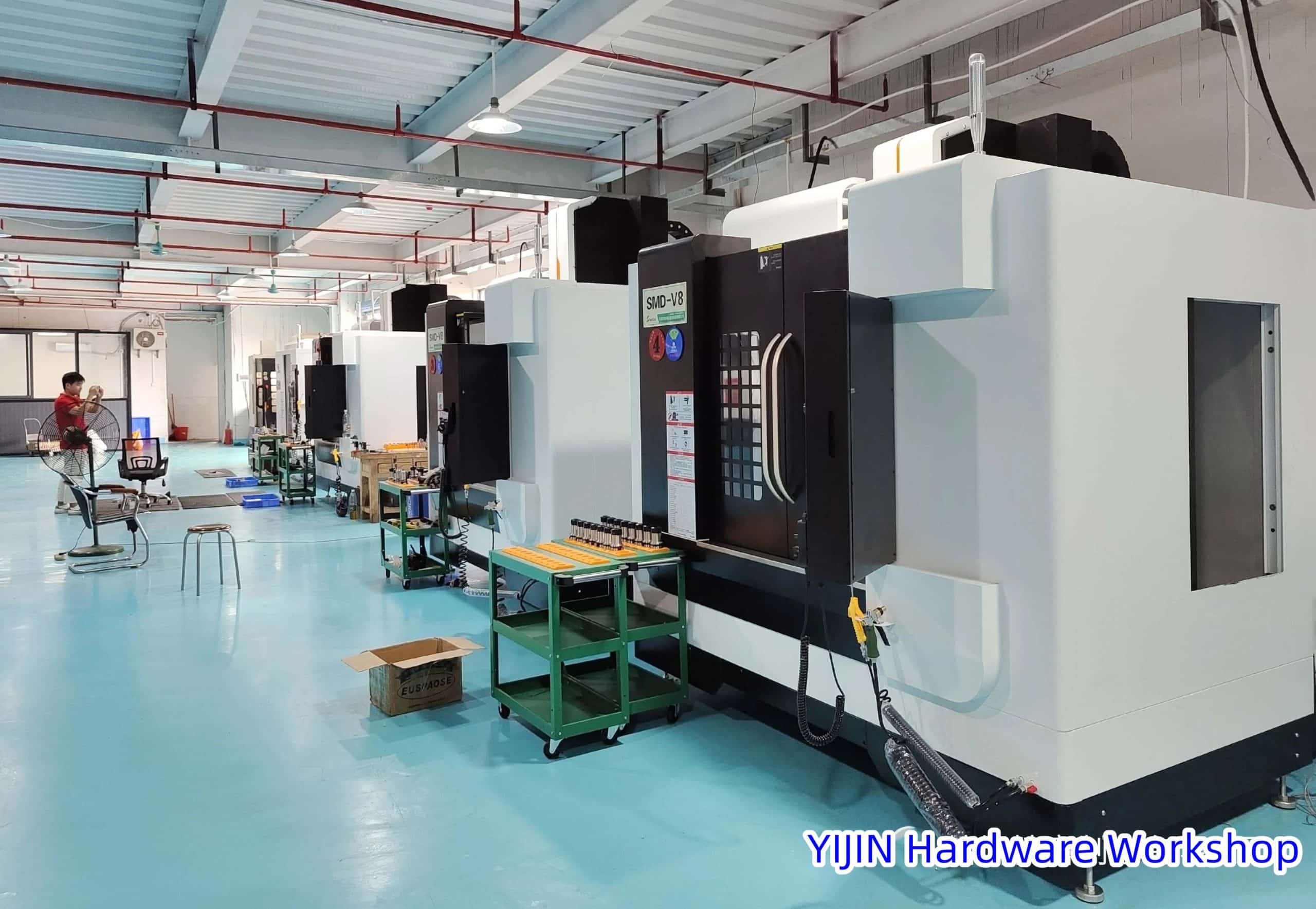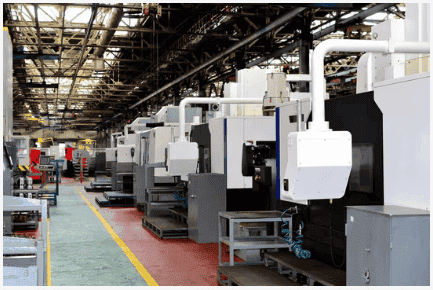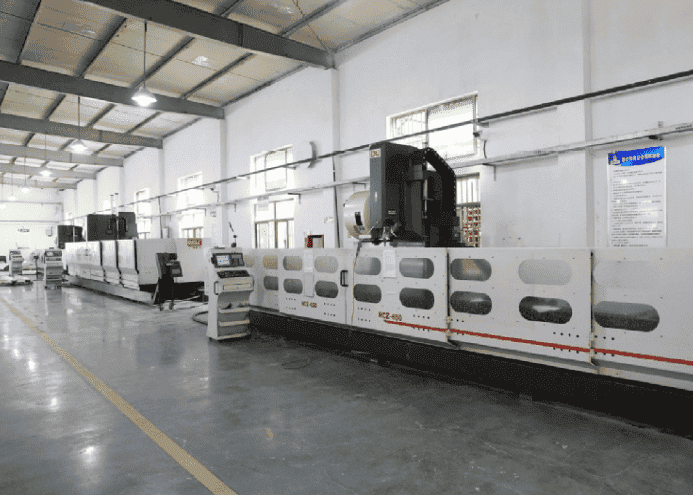Rivets are the most widely used fasteners for the assembly of products. You need to assemble different parts to make components. Rivets work as a joint maker in the manufacturing industry.
But if you talk about fasteners they are not like the usual bolts and nuts. A rivet is a vital part of any manufacturing industry. They have incredible capabilities for both heavy and light applications.
You must understand the types of rivets available for use. It is crucial to choose the right type of rivet if you want your joint to be strong and durable.
If you don’t have a clear idea about different rivets, you are at the right place. We will explore different types of rivets in this article.
So that you can select the best option for your projects. Now let’s explore the types and uses of rivets. Before we move on to the main topic, find out what rivets are.
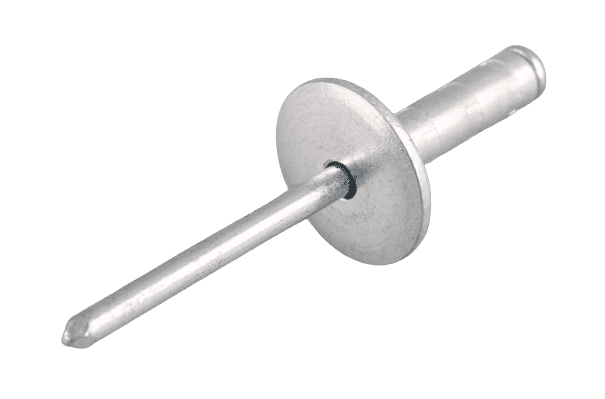
What is a Rivet?
A rivet is known as a mechanical fastener. It is used to fasten and connect two parts (or components) through holes to make them as a whole.
This form of connection is called rivet connection, or riveting for short. It belongs to the non-detachable connection.
If two parts that are joined together are to be separated, the rivet bolt on the parts must be broken.
People use rivets for joining one or more pieces of material together. It provides a durable, long-lasting joint.
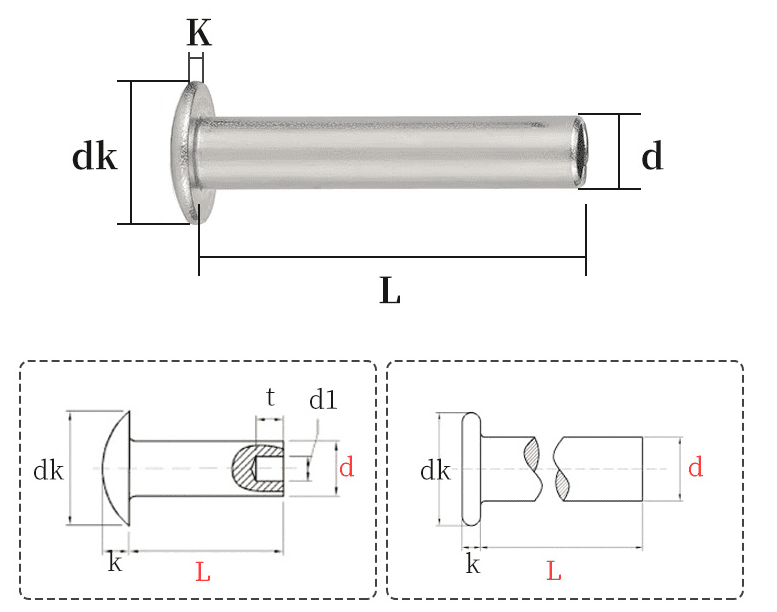
Rivet is a kind of permanent fastener that cannot be removed or undone. Besides construction, automotive, marine, and aerospace, rivets are useful in many other industries.
The basic structure of a rivet consists of a head, a smooth cylindrical body, and a tail.
The tail looks more like a metallic pin. The head is typically larger than the body. It holds the material being joined in place.
The body is inserted into a pre-drilled hole in the material. And the tail is then deformed or “mushed” using a special tool to create a bulge that holds the material together.
This deformation process is known as “setting” the rivet.
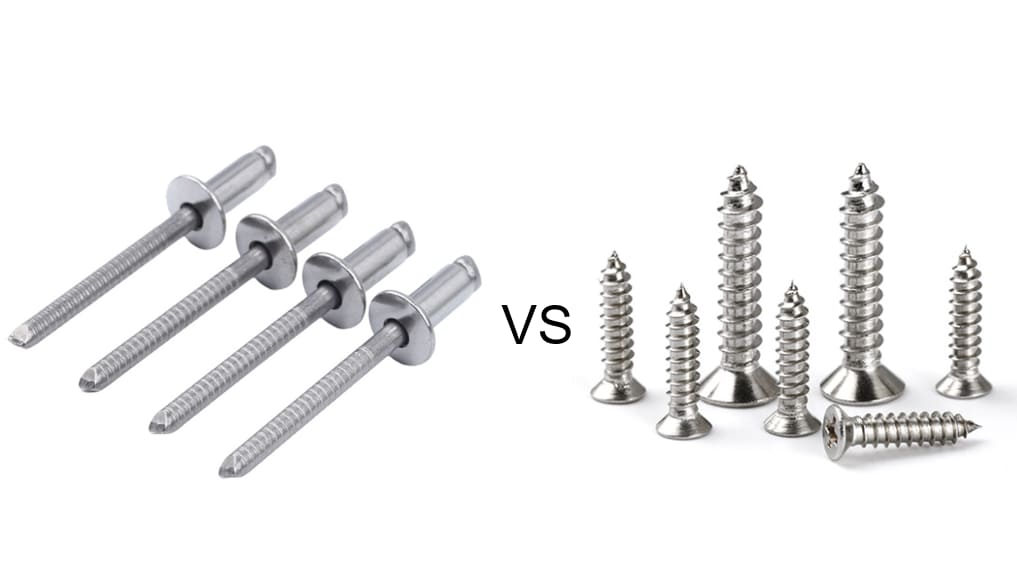
The difference between rivets and screws:
Rivets deform by themselves, generally, one end becomes larger, connecting two (or more than two) parts together.
After riveting, if we want to split the part, we must break the rivet nut.
The screw is screwed into the body of the part through the thread to connect the parts.
Therefore, if you want to disassemble the part, you only need to unscrew the screw.
The screw is not damaged and can be used repeatedly.
In general: The screws are easy to adjust during use, and the rivets are not easy to adjust.
Screws are movable fasteners and rivet screws are fixed fasteners.
Rivet: In riveting, the parts that are riveted are connected by their own deformation or interference.
Recommended: 2023 Top 10 Best Rivets Manufacturers In China
What is the Working Principle of Rivets?
As we mentioned before, the rivet is an essential tool for the manufacturing industry. There are several ways you can install rivets.
The method of installing rivets depends on the needs. You can drill, punch, or insert them into a hole to build a joint. In most cases, rivets are attached by drilling a hole.
The specific method used to deform the rivet end depends on the type of rivet. For example, solid rivets require the use of a hammer or pneumatic hammer to deform the end.
Installing the rivet and deforming the end creates a tight, secure bond. The bond is permanent, and you need a specific mechanism to remove or undo the connection.
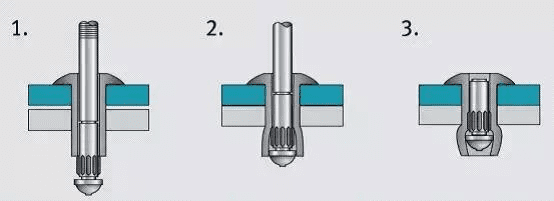
Different Types of Rivets
For centuries, rivets have been used to join materials in various industries. In most cases, industries use rivets to connect two pieces of material permanently and firmly.
There are several types of rivets, each with its own application and design.
1. Solid Rivets
First, to our list of rivets is a Solid rivet. This is the most common type of rivet. It consists of a piece of metal that has a head on one end and a shank on the other.
Solid rivets are typically made of materials like steel, aluminum, or copper. Their strength and durability make them ideal for heavy-duty applications.
With a rivet gun or hammer, shafts and heads are deformed to form solid rivets.
They can have either 100-degree countersunk heads or round universal heads. Solid rivets are often utilized in cases where safety and reliability are critical.
Mainly used for riveting various thin structural parts in vehicles, ships, construction, machinery, electronics, and other industries.

2. Blind Rivets
Blind rivets, also known as pop rivets, are a popular type of rivet used when access to one side of the material is limited. They consist of a mandrel, a hollow rivet body, and a head.
The mandrel is inserted into the hollow rivet body, and as it is pulled, the body expands. Which helps to create a permanent bond. Blind rivets are commonly used in the automotive, HVAC, and sheet metal industries.
In 1916, when H. V. White of the British Aircraft Manufacturing Company first obtained a patent for a blind rivet that can be riveted on one side, people hardly expected that this kind of rivet screw would be so widely used today.
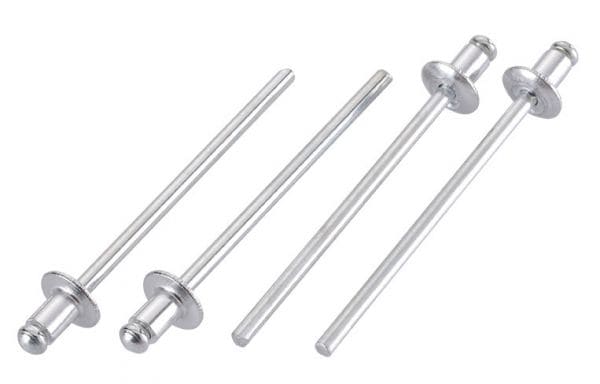
Here are some common types of blind rivets:
Standard Blind Rivets
This is the most basic blind rivet, consisting of a mandrel, hollow body, and head. Compared with ordinary blind rivets, the rivet has a lower riveting strength and is suitable for connecting parts with relatively soft materials.
Structural Blind Rivets
These are high-strength blind rivets that are designed for heavy-duty applications. They have a larger diameter and thicker walls than standard blind rivets. As a result, they can withstand greater loads and stresses.
Multi-Grip Blind Rivets
Their unique design makes them compatible with materials of various thicknesses. They have a range of grip lengths to create a secure bond between materials that do not have thickness. Multi-grip blind rivets are common in the automotive, HVAC, and sheet metal industries.
Peel Blind Rivets
Peel blind rivets have a special mandrel to peel back onto the blind side of the material. This makes them ideal for use in applications where a larger bearing surface.
Grooved Blind Rivets
Grooved blind rivets have grooves on the shank. Which allows the rivet to create a stronger grip on the material. These are commonly used when joining plastics or smooth metal surfaces that are prone to slipping.
The types of blind rivets can show their unique advantages in a relatively small space or in an environment where there is no rivet gun or a rivet gun cannot be used.
3. Tubular Rivets
Basically, tubular rivets consist of a shank, a head, and a hollow tube. The Tubular rivets that are made from brass, copper, or aluminum are used in the leather industry.
It is also commonly used in electric devices and components.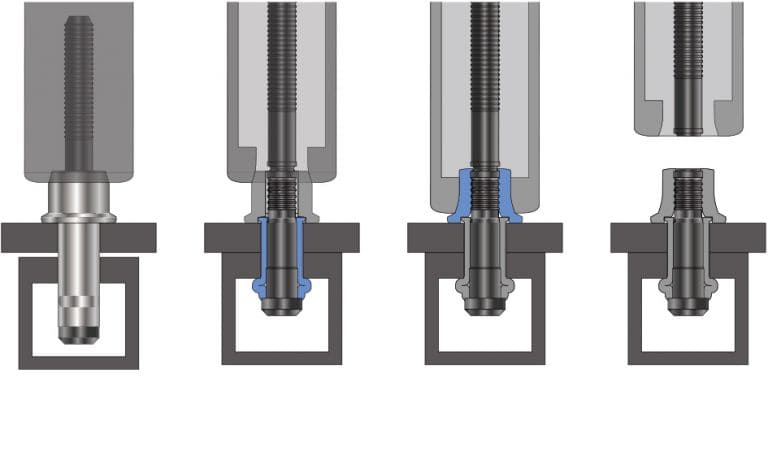
Tubular rivets come in several types, including:
Solid tubular rivets
Made up of a hollow tube with a solid end, these are the most basic tubular rivets.
Semi-tubular rivets
These rivets are commonly used where they need to be easily removed.
Split tubular rivets
These rivets have a split in the tube, allowing them to expand and grip the joined materials. They are often used to join materials that are relatively thin.
Shoulder tubular rivets
Their wide heads and shafts create a shoulder to keep the rivet from pulling through the joining material. Strong, permanent joints are often required in applications using them.
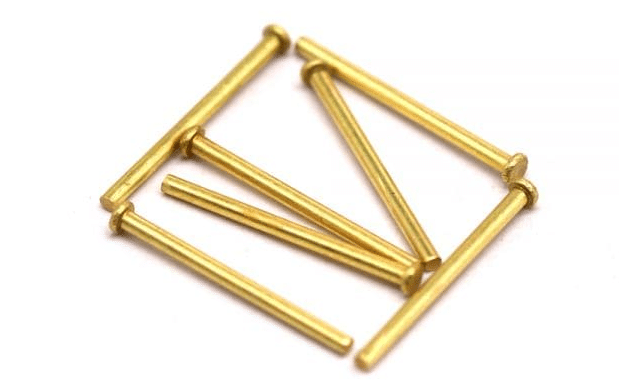
Knurled tubular rivets
Knurled shafts provide extra grip and prevent the rivet from rotating once installed. These types of rivets are good for smooth and slippery materials.
Full Tubular Rivets
Compared with half-tubular rivets, the biggest feature of full-tubular rivets is that the holes must be drilled deeper to operate.
They penetrate softer materials such as plastics and fabrics more easily.
Countersunk tubular rivets
These rivets have a countersunk head that sits flush with the surface of the material being joined. The rivets are ideal for applications requiring a smooth, flush finish often use them.
4. Split Rivets
Split rivets ( or bifurcated rivets) are ideal for joining softer materials. This type of rivet is split at the end of the shank, made of brass, copper, or steel.
People use them to manufacture leather goods, hand bangs, plastic products, etc.
Split rivets are mainly used in the home improvement industry, so they are also called bifurcated rivets. They are the best choice for joining leather goods, plastics, and wood.
Besides, split rivets are quite popular for home repair work. These rivets have split or sawed bodies and are not advisable for extreme or critical applications.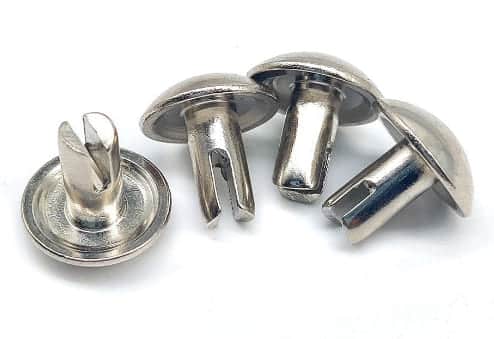
5. Shoulder Rivets
Should rivets be suitable for tight fit and strong bonds? The rivets are also known as shoulder screws and consist of a head, a shank and a shoulder.
It is commonly used in the aerospace, automotive, and construction industries. The rivets are made from steel or brass.
6. Drive Rivets
Drive rivets, also known as speed rivets, provide quick and easy installation. Each consists of a head, a shank, and a mandrel.
The mandrel is inserted into the shank, and it is driven into the material. After that, the shank expands and creates a permanent bond.
It is important to note, however, that drive pin rivets have less clamping force than many other types of rivets.
Drive rivets are commonly used in the automotive, HVAC, and sheet metal industries.
7. Self-Piercing Rivets
Users don’t need to drill or punch holes to use these types of rivets. This category of rivets does not call for the need to drill or punch holes before use.
The rivet ends feature a bevel drill or chamfered poke to pierce the components.
Self-piercing (SPRs) rivets are suitable for use in high-stress applications. SPRs can join dissimilar materials that are difficult to weld together, such as aluminum and steel.
The manufacturing industry can automate the riveting process and increase production. This helps to keep the consistent quality of the products
8. Friction Lock Rivets
The friction lock rivets are similar to expanding bolts. They are also known as interference lock rivets or Huck lock rivets. Most of these rivets are made in a cupola or countersunk way.
The rivets have a tapered shank and a collar that is pulled up against the materials. By clamping the materials together, they ensure a strong and permanent joint.
They are ideal for joining materials of different thicknesses.
Friction lock rivets are easy to install with standard riveting tools. They can be used to join metals, plastics, and composite materials.
Even so, rivets are not good at withstanding high temperatures.
The Usage Area of Rivet In Different Industry
Construction and Infrastructure
The construction industry commonly uses rivets to join structural steel beams and other components. They are also used in infrastructure projects like bridges, dams, and tunnels.
These applications benefit from rivets’ high strength and durability.
Automotive Industry
A rivet is a fastener that joins components such as body panels, chassis components, and other parts in the automotive industry.
It is particularly useful for joining dissimilar materials, such as aluminum and steel. High-stress applications benefit from rivets’ resistance to vibration and fatigue.
Aerospace Industry
Rivets on Aircraft: Aircraft as a common vehicle, its robustness is an important proof of safety.
The materials used in aircraft are strong, durable, and resistant to corrosion, and good materials require good tools to hold them together.
At present, riveting, welding, and bolts basically meet the requirements of aircraft parts assembly.
Due to their lightweight nature, rivets are ideal for aerospace applications that require weight reduction.
Besides, their flexibility and strength make them safe for different applications. They are used in aircraft to connect wings, fuselages, and landing gear.

Electrical and Electronics Industry
The electrical and electronics industry uses rivets to join circuit boards, battery terminals, and electrical contacts. They provide high-current and temperature-resistant joints.
Marine Industry
Ships and boats, for instance, use rivets to connect the hull, deck, and frame together. Rivets are ideal for marine applications due to their high strength and corrosion resistance.
Furniture Industry
Rivets are also used in the furniture industry. They can connect furniture components like frames, legs, and arms. For people to sit or lean on, they ensure a strong, durable joint that can support their weight.
Sports Equipment Industry
Rivets are used in the sports equipment industry for joining components such as bicycle frames, ski bindings, and skateboards.
The high strength and durability of rivets make them ideal for these applications.
Materials Used For Rivets
What are rivets made of? The material of rivets can be aluminum, iron, stainless steel, copper, and other materials, and different materials have different advantages and disadvantages.
Aluminum rivets have low density and are lightweight, but long-term exposure to aluminum to humid air produces white aluminum oxide.
Copper rivets are soft and ductile, but not as strong as stainless steel and are easily oxidized.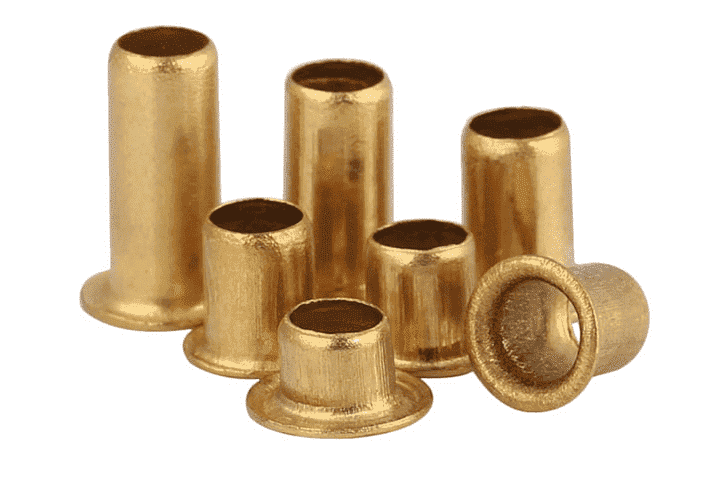
Iron rivets have a high tensile force but are easy to rust.
Steel has low-carbon properties, and it can be used to engage parts well after being made into rivets.
More specifically, rivnut is punched in a cold heading machine with materials such as aluminum, stainless steel, iron, brass, and red copper.
In order to prevent corrosion and oxidation, rivet nuts are generally surface-treated. The usual surface treatment methods are nickel plating, zinc plating, chrome plating, and painting.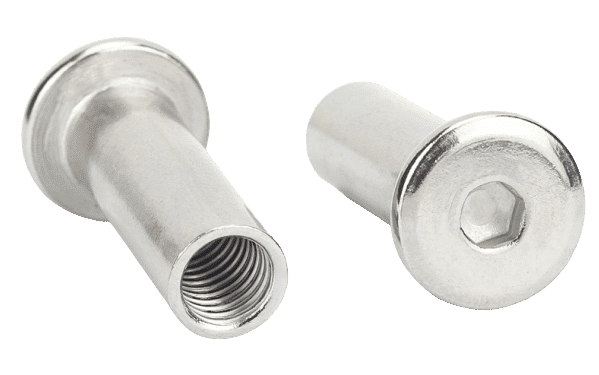
Advantages of Using Rivets
The primary purpose of using rivets is to ensure long-lasting joints. It ensures a reliable connection between two parts or materials.
It is very useful for consumption, transportation, and manufacturing. Let’s find out the advantages of using rivets.
Offer Permanent Bond
One key advantage of rivets is creating a permanent connection. They’re ideal for applications that don’t require disassemblies, like airplane construction or shipbuilding.
Once a rivet is set, it creates a strong and secure joint that will not come apart.
Easy Installation Process
The process of installing a rivet is very simple. All that is required is a pre-drilled hole in the material being joined and a rivet gun to set the rivet.
This makes them a cost-effective and efficient solution for joining materials together. Besides, you don’t need extreme expertise to do the job.
Long-Lasting Joint
Rivets also offer excellent resistance to vibration and other external forces. After a rivet is set, it expands and creates a tight, secure seal.
This ensures that the joint remains strong and stable. Vibrations, shocks, and other external forces will not affect the joint.
You can use rivets in applications where access to the back of the material is limited. Blind rivets are ideal for use when the back of the material is not accessible.
Various Options Available
Rivets come in a variety of sizes and materials. As a result, they can be used for a variety of projects. They can be made from steel, aluminum, brass, and copper.
It ensures greater versatility and flexibility in choosing the right one.
Disadvantages of Using Rivets
Limited Flexibility
Once a rivet is installed, removing or adjusting is difficult. This lack of flexibility can be a disadvantage when repairing the pre-joint materials.
Damage to Materials
In most cases, you need to create a hole joint in the materials using rivets. This can cause damage to the materials and may weaken the overall structure.
Corrosion
Several types of rivets are corrosion-resistant, but others can rust or corrode over time. Which weakens the joint and may cause the materials being joined to fail.
Additionally, it does not grant a tight and leak-proof joint.
Surface Preparation
You have to prepare the material’s property before using rivets. This can require additional time and effort compared to other fastening methods like screws or bolts.
Noise and Vibration
Vibration or movement may cause rivets to make noise in some applications.
Cost
Rivets can be more expensive than screws or bolts. Riveting needs more time and labor consuming than welding. Besides, the labor costs of rivet joints are relatively high.
Conclusion
Hope you got a complete idea about different types of rivets and their usage. Rivets are essential in various industrial applications. A rivet is a superior alternative to screws, bolts, and nuts.
It provides a strong, reliable, and permanent joint between two or more materials.
In the end, what is a rivet used for, and how to choose rivets of different materials should be selected according to different needs? Yijin Hardware Co, Ltd is a professional rivet manufacturer integrating design, production, and sales.
Our products include all kinds of fasteners, such as stainless steel rivets open-end rivets, closed rivets, drum rivets, drawing rivets, and light rivets, lantern rivets. Welcome new and old customers to visit our company for exchange and cooperation.
2023 Top 10 Bolts and Nuts Manufacturers in China
FAQs
What are the most common types of rivets?
Solid, blind, tubular, and metal piercing rivets (including split rivets) are the most common types of rivets.
What is the material used to make rivets?
There are several metal materials for manufacturing rivets. These materials include steel, copper, brass, aluminum, copper, and stainless steel. According to their needs, manufacturers and designers choose these different materials
What is a rivet tool called?
Rivet guns also called rivet hammers or pneumatic hammers are known as rivet tools.
Why use rivets instead of welding?
Unlike welding, riveting creates a joint that can flex slightly. Riveting can be a relatively simple and quick process, especially compared to welding. Besides, you can use rivets for joining different types of material.
Is rivet better than screw?
Rivets are more durable than screws since they ensure a long-lasting bond. Due to the fact that rivets have heads on both sides, they provide support on both ends of the joint.
What is the best type of rivet?
There is no exact answer to the question. The type of rivet you choose depends primarily on your project requirements.
 Call Us Today! (+86) 188-2253-7569
Call Us Today! (+86) 188-2253-7569